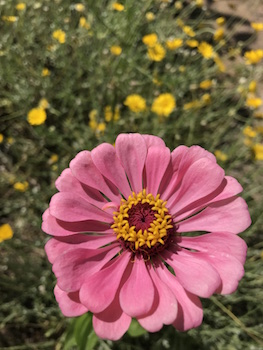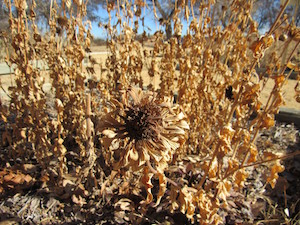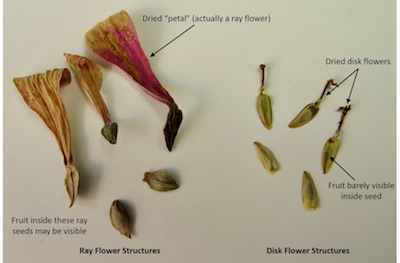Question: I have a large monarch butterfly garden, and I gathered zinnia seed heads to plant next spring. Zinnia seeds appear to have two distinct morphologies. The ray flower seed is shield-shaped and the disk flower seed is smaller and flatter. Which of the seeds is viable? I have researched and found some who say only the ray seed, some say only the disk seed, and some say both. Please let me know which zinnia seed is most viable and why.
Tim P., New Mexico
 Zinnia showing off both disk and ray flowers at the NMSU Agricultural Science Center in Los Lunas. Photo credit M. ThompsonAnswer: I know exactly what you mean. I’ve had this question before myself. Zinnias were one of my first garden successes when I moved to Las Cruces in 2009. I too gathered the seed heads and I too wondered which part was the true seed that should be saved. That year I just saved the whole shebang. In the late spring I crunched up the entire dried flowers and sprinkled them around the garden. It worked, so I kept that routine right up to today.
Zinnia showing off both disk and ray flowers at the NMSU Agricultural Science Center in Los Lunas. Photo credit M. ThompsonAnswer: I know exactly what you mean. I’ve had this question before myself. Zinnias were one of my first garden successes when I moved to Las Cruces in 2009. I too gathered the seed heads and I too wondered which part was the true seed that should be saved. That year I just saved the whole shebang. In the late spring I crunched up the entire dried flowers and sprinkled them around the garden. It worked, so I kept that routine right up to today.
Our office building at the NMSU Agricultural Science Center at Los Lunas was surrounded by bright zinnias for much of the summer and fall. The crispy brown stalks with scraggly seed heads are still here—partly because the hollow stems are a possible habitat for overwintering beneficial insects and partly/mostly because I haven’t taken the time to clean up the garden for winter. (New Year’s resolution?)
 Messy gardens can be great habitats for overwintering bees and other beneficial animals. Photo credit M. Thompson.
Messy gardens can be great habitats for overwintering bees and other beneficial animals. Photo credit M. Thompson.
I’ve seen several pro-messy garden posts on Facebook gardening pages this season. Articles from wildlife conservation groups, like the Audubon and Xerces Societies, explain the benefits of skipping some winter chores so native bees and birds have plenty of habitat and nesting material. For links to more info that will massage away the lazy gardener’s guilt, visit here. You’re welcome.
Zinnias are native to the Americas. In our neck of the desert you may come across Zinnia grandiflora or Z. acerosa, also known as plains and desert zinnia, respectively. Zinnia elegans, Z. angustifolia and Z. peruviana, the species common in landscaped flowerbeds, are native to Mexico and South America.
As far as knowing which part of the zinnia flower to save for reseeding next season, we need to review a little botany. Zinnias are in the aster or sunflower family, which is the second-largest family of flowering plants, behind orchids. Imagine a classic sunflower with yellow petals making a ray around a dense disk of tightly packed black sunflower seeds. Each of those yellow petals in the ray is actually an individual flower, so they’re not really petals. And each of the sunflower seeds in the disk was also a flower earlier in the year. Not all asters have both ray and disk flowers. They can be ray-only (like dandelions), disk-only (like thistles), or a combination (like many sunflowers, black-eyed Susans, and zinnias). On top of that, either floral structure may or may not be fertile. In sunflowers, the disk flowers produce the seeds and fruit, but the ray flowers are sterile.
I asked my co-worker, Alissa Freeman, who has a background in botany, to help me dissect our dried zinnia seed heads to find the actual seeds and learn more about flowering. She introduced me to a great online botany resource here. It turns out viable seeds can be found in both the ray and disk flowers in zinnias. Alissa was able to pop open the dried seed coating to expose a little seed (achene) in some ray flowers, but many were empty. And we could see the hiding seed in some of the disk flowers by holding them up to the light. But it wasn’t easy.
Bottom line—it would take too much work to pick out the viable seeds, and since both ray and disk flowers can be fertile on zinnias, just keep the whole thing. Gotta be smart to be lazy.
 Photo Courtesy of M. Thompson
Photo Courtesy of M. Thompson
For more gardening information, including decades of archived Southwest Yard & Garden columns, visit the NMSU Extension Horticulture page here or contact your County Extension office here.
Marisa Thompson, PhD, is the Extension Horticulture Specialist for New Mexico State University and is based at the Agricultural Science Center at Los Lunas.


